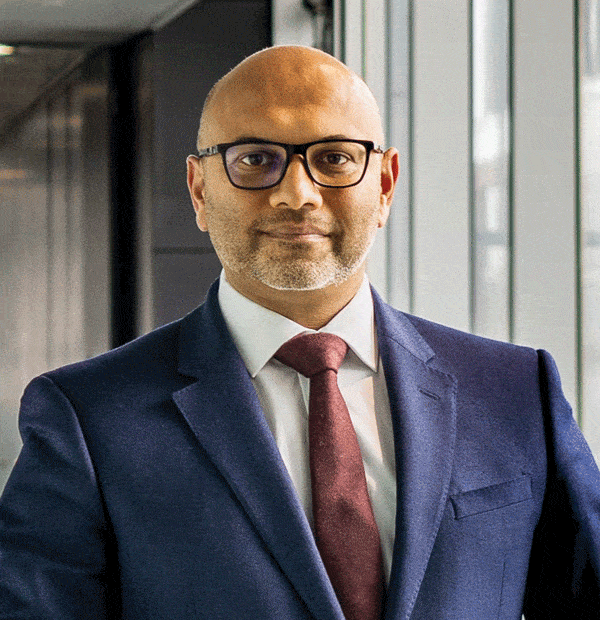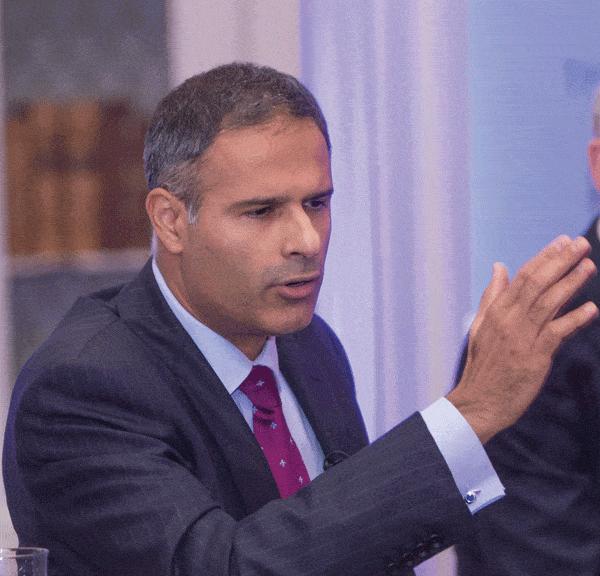It is a complex world. Globalisation, increasingly interconnected economies, decades of tougher regulation and, yes, frenetic levels of law making across the world mean that getting business right is harder than ever and not all the proliferating risks can be managed.
All perfect conditions for litigators, which is why much of the post-banking crisis boom in legal services has been driven by demand for contentious law, rather than the transactional work that used to underwrite the high-end legal market.Unsurprisingly, in-house teams have in turn built up their own litigation, regulatory and compliance capability. Heavily-regulated industries, consumer-facing companies and financial institutions lead the way. Major banks can field in-house litigation teams of between 15 and 40 people in the UK, and are widely considered the most sophisticated.
We are not shy about challenging the way we operate if the business can still achieve its commercial objectives, but with less risk.
Nick Vidovich, Vodafone
Yet, the unpredictability of disputes means many large companies still keep it ad hoc. For example, the London Stock Exchange has no dedicated litigation team, while the UK arm of insurer AXA has offloaded litigation entirely to panel adviser DAC Beachcroft.
As Standard Life Aberdeen general counsel Rushad Abadan, previously of The Royal Bank of Scotland, notes: ‘If your cost base allows it, it’s better to have a specialist litigation, regulatory and investigations team, particularly in financial services. To have that capability in-house is cost-efficient but also means you’re building up institutional knowledge and can take steps thereafter to make sure these things don’t reoccur.’
To assess the growth of in-house litigation teams, The In-House Lawyer interviewed GCs and heads of litigation at more than 15 companies, including 11 from the FTSE 100. While some have built sizeable internal capability – Shell’s team is more than 100 – the vast majority have only a handful, while a few have between ten and 20.
Slaughter and May disputes head Sarah Lee comments: ‘I’ve been in practice for a long time and over the years there has definitely been a rise in in-house litigation teams. It used to be that it wasn’t easy for litigators to move from private practice to in-house, although it still very much depends on the nature of the business as to how big the teams are.’
A new discipline
The highly-regarded litigation team at oil and gas giant Shell is one of the biggest. Its 130 staff, led by GC for global litigation Richard Hill, is made up of 85 lawyers supported by paralegals and e-discovery specialists. The team also makes up a higher proportion of the wider legal function – Shell’s global team tops 1,000 – than most companies.
But there was no dedicated contentious team at Shell as recently as 2012 when Hill, a former Norton Rose Fulbright partner, joined. ‘We were still in a world where litigation was being managed by business lawyers in whichever area the litigation arose and we wanted to professionalise this, so we did a review and created a global litigation team.’
Shell has made a concerted effort to undertake more litigation work in-house, with two thirds of the dispute team’s legal spend now spent internally. Existing lawyers were re-tooled to work in litigation and others recruited, while new procedures for managing cases were introduced.
‘We have disciplined tools around managing litigation and we are rigid in our approach – when a case arises we have a clear process and will go through a detailed plan in keeping with the company’s business objectives,’ notes Hill. ‘In the old days we’d let a case run and settle on the door of the court, but now we have things like early case assessments and global management systems that allow us to track cases. We are pro-active at looking at trends and intervening when we need to.’
Hill uses external counsel for court representation in jurisdictions outside the UK. The company is often on the receiving end of litigation: it is facing a fresh lawsuit from environmentalist campaigners in the Netherlands over cutting its use of fossil fuels, for instance. Managing the high expense of litigation is a priority.
‘We can put a case to two or three firms and that incentivises firms to think about how they are going to do the job efficiently – the pressure is on them and not us, which is a revolutionary approach for us.’

Richard Hill, Shell
The litigation team at telecommunications group BT – which has more than 350 in-house lawyers overall – is also highly rated, managed by director of legal for litigation Michael Isaacs, a former TLT partner, who joined last November.
BT has two main litigation hubs: a centre-of-excellence team of six lawyers and two secondees within the corporate legal team in London, and a team of 35 in Sheffield. The former deals with the ‘financially, strategically and reputationally’ significant BT disputes, while the latter is a volume arm handling employers’ liability, personal liability and motor claims.
The majority of disputes are handled internally, but the team will also instruct the Bar directly, use contractors and legal process outsourcing, as well as external law firms. BT’s legal panel is used for when in-house capacity is unlikely to be sufficient, if a case involves a ‘particularly esoteric’ area of law, and where the significance of a case requires an external view. Isaacs is focusing on building relationships with a few core firms to support litigation and investigations work.
‘We have our own e-disclosure system, which we use for lots of cases. We will outsource though if it is justified by the volume of data or if there is likely to be a need to use tools that we do not have ready access to in-house.’
Even then, the ligation team will lead on translating external legal advice for BT’s stakeholders. Isaacs sees his team’s job as making sure firms give advice in a consistent way and helping them make it digestible for the company, with a focus on commercial objectives and giving clear recommendations.
Like Hill, Isaacs is pushing advisers on price: ‘We are seeing more willingness on the part of certain firms to pin their colours to the mast on cases and commit to fixed or capped fees. The value of that certainty is immense and certainly gives those firms a competitive advantage.’
For the Bank of England, a litigation and enforcement department was established in 2013 to coincide with the formation of the new regulator, the Prudential Regulation Authority (PRA). There were roughly seven lawyers with a wide remit.
However, when Miles Bake, the head of legal, enforcement and litigation at the central bank, took his position in 2016, the PRA was undertaking more investigations into potential misconduct by banks and insurers.
The team has since expanded to just under 30 staff – within an overall function of more than 150 – and its focus has shifted towards enforcement and investigations work. One of the more high-profile cases saw the PRA and Financial Conduct Authority (FCA) jointly fine Barclays chief executive Jes Staley more than £600,000 after he used the bank’s internal systems to try to identify a whistleblower.
‘We haven’t seen it too much yet, but in our enforcement work we will decide whether a firm or an individual should be fined and be prohibited from banking,’ he says.
Critical mass
The middle tier of in-house litigation teams includes GlaxoSmithKline (GSK), Uber, Santander and SEE, which have each built up internal capability to deal with growing regulation in their respective sectors.
Antonio Suarez-Martinez, assistant GC at GSK, heads up the pharmaceutical company’s UK litigation team, which consists of four litigators and is part of a wider global team of around 20, reporting into global head of disputes, Brennan Torregrossa, in the US.
The company will outsource if internal capacity is challenged, but it also depends on how critical a case is. Suarez-Martinez says pharma disputes typically involve product liability, regulatory investigations and disputes with third parties. The internal team’s focus is on resolving issues before they go to court, however. He comments: ‘The benefit of having a litigation team is that the commercial lawyers can be freed to focus on advising the business rather than getting distracted.’
Santander UK’s 16-lawyer litigation team splits into four areas covering contentious matters: regulation, retail litigation, corporate strategies and strategic employment. Deepun Haria, litigation and contentious regulatory director at the bank, joined five years ago when there were just three staff focused on contentious regulation.

Deepun Haria, Santander
‘Shortly after I joined, it became apparent the work coming in was reactive to claims being issued against us. The size of the team now reflects that litigation has a role to play in a variety of issues and in managing risk in parts of the organisation that litigation could arise.’
Haria describes his team’s role as providing oversight of the parts of the business from which litigation could originate. When UK legal chief and regulatory officer John Collins joined in 2016, the bank reviewed its in-line support for contentious matters and how they were handled; Haria says it is not just about being a conduit to external counsel.
‘Clearly, cost is a driver for having litigation teams in-house and we have to demonstrate value. We have to show the benefits a critical mass of in-house litigators and contentious regulatory lawyers brings as against the counterfactual.’
Freshly-listed Uber has had its share of litigation and regulatory issues in recent years, notably with Transport for London over its private-hire operator licence and court action over the employment classification of Uber drivers.
But outside the US, where Uber has over ten litigators, there is not a dedicated litigation team because of the challenges of different court proceedings in different countries. Three regulatory and litigation lawyers and four employment lawyers handle disputes in the UK, reporting into Uber associate GC for Europe, the Middle East and Africa, Matt Wilson.
To keep costs down, Wilson will go directly to barristers for complex matters in the county court or small claims court. But in jurisdictions outside the UK, the company leans heavily on external law firms. ‘We work with cities and policymakers on the regulatory side, and on the litigation front we are often looking to clarify how old law applies with new technology and litigation can influence how well old law can be interpreted in a modern age, which is incredibly interesting.’
Gaby Dosanjh-Pahil, head of legal dispute resolution at Big Six energy provider SSE, has grown her team to 14 lawyers from just two when she joined the company in 2002.
‘The energy sector is heavily regulated with some whistleblowing issues, but it’s largely contentious construction work because we’ve got lots of projects going, like building wind farms. We’ve got a panel and we only outsource if we don’t have the resources. We monitor issues in-house closely: our board and directors like to have on-tap in-house strategic advice and external firms don’t have that relationship.’
No hospital pass
The vast majority of in-house legal departments, however, only carry litigation teams of about five or fewer. Many help manage workflows with external law firms, while also improving and monitoring compliance.
Anglo American has five litigators between London and Johannesburg, but most litigation is outsourced. GC Richard Price observes: ‘The team is integrated with the external lawyers and it’s our view that it’s more effective to have an in-house team acting as a go-between with the law firms. It’s not a matter of reallocating the work away from the law firms – it’s about managing disputes internally to achieve a better outcome.’
Standard Life Aberdeen has just three lawyers in a litigation and regulatory investigations team, headed by Gavin Davis. While a financial institution, the volume of work the team handles does not compare to a large bank, Abadan says. ‘If it’s something relatively minor or an engagement with the regulator, we tend to deal with that in-house, or might instruct outside counsel on bespoke procedural aspects. We go to external when something is meaningful in size or presents a material risk – that could be a financial or reputation risk. It’s a judgemental threshold.’

Rushad Abadan, Standard Life Aberdeen
Two recent examples that used external counsel include a large arbitration matter with Lloyds Bank over a £100bn-plus investment mandate the bank withdrew last year, as well as an ongoing FCA investigation in relation to historic annuity sales.
BAE Systems’ disputes work all went externally when Philip Bramwell joined as legal chief in 2007. He quickly created a head of dispute resolution role, now headed by David Pawan with support from a lawyer and secondee. The role established oversight on the company’s relationship with its law firms: ‘My concern was that we were just lobbing stuff over the wall at law firms and then paying a big premium for them to get up to speed – we weren’t sending them proper files, proper correspondence, proper sets of legal instructions.’
He adds: ‘It’s about managing the external firms effectively and containing costs by giving them effective instructions. That’s what can really rack up a bill if you just send them a hospital pass.’
Capita’s disputes team of four did not exist until head of litigation Emma Emery joined the company nearly three years ago, with the company’s commercial teams previously managing disputes before outsourcing to law firms.
Emery’s mandate was to establish a clear operating model for how disputes were handled: when her team stepped in versus when it should be left to the business, as well as at what point work should be outsourced. The baselines for outsourcing are if the team does not have the relevant expertise or if they are struggling for capacity.
‘Even when we outsource, we’re still looking at ways in which we just don’t hand over everything and start paying a fortune for an external law firm. We’ll sometimes get a specialist QC on a discrete point.’
Rolls-Royce chief counsel for litigation and dispute resolution Charlotte Digby is part of a two-strong UK team with another two litigators in the US. She sees her role as being able to spot issues early and raise awareness within the company, reporting to the board twice a year.
Digby refers to the company’s external lawyers as an extension of her own team: ‘The two must work closely together. The internal team has a critical role throughout a case doing all the bits the external teams aren’t doing, like briefing the managing stakeholders.’
Luke Ryan, head of procurement, property and dispute resolution at Royal Mail, leads a small but well-regarded team of four. He believes the advantage of having an in-house team is that it can step into the fold of a developing issue before it gets to a more formal litigation stage.
‘We endeavour to deal with things in-house. For instance, a couple of years ago we handled a significant arbitration in-house and briefed a QC, but we’ll outsource a document-heavy dispute because we’re not equipped to handle it.’
Vodafone group legal director for litigation Nick Vidovich leads a team of four, which manages global litigation and internal investigations. It sits in the parent company, handling large, complex cases, such as patent litigation, supplier and government disputes, rather than direct customer-related issues.
External firms are used for court appearances and cases where there may be many documents and witnesses, but otherwise the company prefers direct access to an in-house team that manages litigation.
‘External lawyers are sometimes brought in to advise on critical issues or decisions, but that is rarely a substitute for a familiar face with inside knowledge of the company.’ He adds: ‘We are not shy about challenging the way we operate if the business can still achieve its commercial objectives, but with less risk.’
The cost of business
Most litigation practitioners, both in-house and law firm partners, say the majority of post-banking crisis litigation has washed through. The focus of litigation teams is shifting as a result.
Eversheds Sutherland co-head of global litigation Paul Worth says the balance between litigation and claims, and regulatory investigations, enforcement, prosecution, internal investigations, compliance and risk management, has tilted in favour of the latter.
‘Higher on the risk register of global executives is the regulatory risk and reputational risk – things that can impact their share price,’ he comments. ‘It’s not likely to be the £100m claim against the company any longer. A data breach, cyber-security event or regulatory investigation, even if it’s ultimately dropped, will have a bigger impact. It’s the reputation side.’
Litigation and handling claims are largely seen as the cost of doing business, but the Serious Fraud Office knocking on the door is not. Every company, too, is tracking risks related to data and possible litigation, particularly in the wake of GDPR.
Companies are also keenly keeping an eye on the Disclosure Pilot Scheme operating in the Business and Property Courts for two years from 1 January 2019, to see what impact it may have on the burden and cost of disclosure. The overall cost of litigation is also seen as hugely expensive, itself a major driver of the willingness to build in-house resource.
As Royal Mail’s Ryan notes: ‘It’s hard and prohibitively expensive even for a big company. Disclosure and the amount of document procedures within business relationships to deal with makes it all an expensive process.’
In-house litigation teams are therefore expected to grow, provided a company has enough work to warrant it. Concludes Slaughters’ Lee: ‘We are starting to see more litigators being promoted to heads of teams in-house. These positions are becoming more highly prized because of the increasing focus on risk mitigation and compliance in companies.’
Complexity, for lawyers at least, has its benefits.
Anna Cole-Bailey and Hamish McNicol


